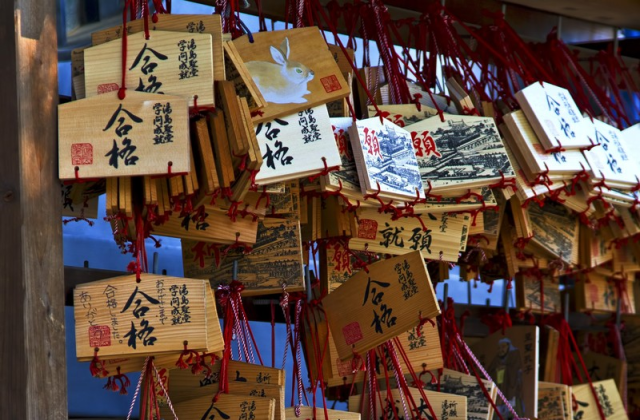
Ema supporting ongoing Hong Kong protests have been crossed out, snapped into pieces, and written over in Chinese.
In the courtyard of Japanese Shinto shrines, and many of the country’s Buddhist temples too, you’ll find racks of ema. Small wooden boards decorated with auspicious illustrations, visitors purchase ema from the shrine/temple attendants and write a wish on it, and once it’s hung on the rack, the gods are supposed to take care of the rest and grant your desire.
It’s a fun tradition that goes back centuries, but in recent months some of Japan’s most prominent places of worship have seen their ema display areas becoming proxy battlefields for a dispute taking place thousands of kilometers away. Kyoto’s Kiyomizu Temple, one of the city’s most famous landmarks and sightseeing destinations, has been finding ema that have been vandalized if their written wishes show support for the ongoing Hong Kong political protests.
▼ Vandalized ema originally expressing support for the Hong Kong protests
香港人の祈願した絵馬に中国人による熱い修正が入ってた
— 看護メン (@nursemens4321) November 17, 2019
絵馬で喧嘩するのやめろ pic.twitter.com/VvpiiScsaf
This isn’t something that’s only happening in Kyoto, either. Nara’s Kasuga Shrine, Osaka’s Hokoku Shrine, and Kagawa Prefecture’s Konpira Shrine have also been reporting similar problems. Ema on which the original purchasers wrote messages such as “Hang in there, people of Hong Kong” and “Liberate Hong Kong, revolution of our time,” a rallying cry for protestors, have had their messages crossed out or written over with “One China.” In extreme cases, the ema themselves have been found snapped into pieces.
It’s worth mentioning that the practice of using ema to wish for broad social changes or world-peace-level aspirations is largely something done by foreign tourists, and the defaced ema that have been found had both their original wishes, as well as any graffiti covering it, written in Chinese or, in some cases, English. Japanese citizens are far more likely to wish for something personal, and while written-in-Japanese ema asking for the health of friends and family are common, so are such secular desires as passing a school entrance exam, finding a boyfriend/girlfriend, or scoring tickets to a coveted idol/boy band concert.
Because of that, it’s debatable how deep of reverence the average Japanese person has for ema. Still, Japan’s shrines and temples don’t want their ema racks turning into venues for Internet-style political bickering, especially for something that’s happening outside their country’s borders. As of November 13, Hokoku Shrine has signs, written in Japanese, English, and Chinese, asking visitors to refrain from acts of ema vandalism.
Source: NHK News Web via Jin
Top image: Pakutaso
● Want to hear about SoraNews24’s latest articles as soon as they’re published? Follow us on Facebook and Twitter!

 At this Kyoto shrine, be careful what you wish for—and how—, because you just might get it
At this Kyoto shrine, be careful what you wish for—and how—, because you just might get it Part of the family – Tokyo Shinto shrine’s blessings for children now available for pets too
Part of the family – Tokyo Shinto shrine’s blessings for children now available for pets too Spirited Away meals and merchandise coming to new Studio Ghibli exhibition in Tokyo
Spirited Away meals and merchandise coming to new Studio Ghibli exhibition in Tokyo Chinese zodiac Evangelion characters are here to wish you a happy, chibi Year of the Ox【Pics】
Chinese zodiac Evangelion characters are here to wish you a happy, chibi Year of the Ox【Pics】 A visit to Japan’s centuries-old boob temple
A visit to Japan’s centuries-old boob temple Seaside scenery, history, and so many desserts on Yokohama’s Akai Kutsu【Japan Loop Buses】
Seaside scenery, history, and so many desserts on Yokohama’s Akai Kutsu【Japan Loop Buses】 Mikado Coffee is a 76-year-old coffee chain with a major celebrity connection
Mikado Coffee is a 76-year-old coffee chain with a major celebrity connection Japanese city loses residents’ personal data, which was on paper being transported on a windy day
Japanese city loses residents’ personal data, which was on paper being transported on a windy day Japan’s summertime towelket pillowcases are even better with the addition of Ghibli stars【Photos】
Japan’s summertime towelket pillowcases are even better with the addition of Ghibli stars【Photos】 Anime girl English teacher Ellen-sensei becomes VTuber/VVTUber and NFT
Anime girl English teacher Ellen-sensei becomes VTuber/VVTUber and NFT McDonald’s new Happy Meals offer up cute and practical Sanrio lifestyle goods
McDonald’s new Happy Meals offer up cute and practical Sanrio lifestyle goods Harajuku Station’s beautiful old wooden building is set to return, with a new complex around it
Harajuku Station’s beautiful old wooden building is set to return, with a new complex around it Do Hi-Chew-flavor Hi-Chews have a reason to exist?【Taste test】
Do Hi-Chew-flavor Hi-Chews have a reason to exist?【Taste test】 Historical figures get manga makeovers from artists of Spy x Family, My Hero Academia and more
Historical figures get manga makeovers from artists of Spy x Family, My Hero Academia and more Suntory x Super Mario collaboration creates a clever way to transform into Mario【Videos】
Suntory x Super Mario collaboration creates a clever way to transform into Mario【Videos】 Foreigner’s request for help in Tokyo makes us sad for the state of society
Foreigner’s request for help in Tokyo makes us sad for the state of society Japanese ramen restaurants under pressure from new yen banknotes
Japanese ramen restaurants under pressure from new yen banknotes French Fries Bread in Tokyo’s Shibuya becomes a hit on social media
French Fries Bread in Tokyo’s Shibuya becomes a hit on social media Studio Ghibli releases new action figures featuring Nausicaä of the Valley of the Wind characters
Studio Ghibli releases new action figures featuring Nausicaä of the Valley of the Wind characters Red light district sushi restaurant in Tokyo shows us just how wrong we were about it
Red light district sushi restaurant in Tokyo shows us just how wrong we were about it New private rooms on Tokaido Shinkansen change the way we travel from Tokyo to Kyoto
New private rooms on Tokaido Shinkansen change the way we travel from Tokyo to Kyoto Tokyo Tsukiji fish market site to be redeveloped with 50,000-seat stadium, hotel, shopping center
Tokyo Tsukiji fish market site to be redeveloped with 50,000-seat stadium, hotel, shopping center Beautiful Ghibli sealing wax kits let you create accessories and elegant letter decorations【Pics】
Beautiful Ghibli sealing wax kits let you create accessories and elegant letter decorations【Pics】 Studio Ghibli releases Kiki’s Delivery Service chocolate cake pouches in Japan
Studio Ghibli releases Kiki’s Delivery Service chocolate cake pouches in Japan New definition of “Japanese whiskey” goes into effect to prevent fakes from fooling overseas buyers
New definition of “Japanese whiskey” goes into effect to prevent fakes from fooling overseas buyers Our Japanese reporter visits Costco in the U.S., finds super American and very Japanese things
Our Japanese reporter visits Costco in the U.S., finds super American and very Japanese things All-you-can-drink Starbucks and amazing views part of Tokyo’s new 170 meter-high sky lounge
All-you-can-drink Starbucks and amazing views part of Tokyo’s new 170 meter-high sky lounge More foreign tourists than ever before in history visited Japan last month
More foreign tourists than ever before in history visited Japan last month New Pokémon cakes let you eat your way through Pikachu and all the Eevee evolutions
New Pokémon cakes let you eat your way through Pikachu and all the Eevee evolutions Disney princesses get official manga makeovers for Manga Princess Cafe opening in Tokyo
Disney princesses get official manga makeovers for Manga Princess Cafe opening in Tokyo Sales of Japan’s most convenient train ticket/shopping payment cards suspended indefinitely
Sales of Japan’s most convenient train ticket/shopping payment cards suspended indefinitely Sold-out Studio Ghibli desktop humidifiers are back so Totoro can help you through the dry season
Sold-out Studio Ghibli desktop humidifiers are back so Totoro can help you through the dry season Japanese government to make first change to romanization spelling rules since the 1950s
Japanese government to make first change to romanization spelling rules since the 1950s Ghibli founders Toshio Suzuki and Hayao Miyazaki contribute to Japanese whisky Totoro label design
Ghibli founders Toshio Suzuki and Hayao Miyazaki contribute to Japanese whisky Totoro label design Doraemon found buried at sea as scene from 1993 anime becomes real life【Photos】
Doraemon found buried at sea as scene from 1993 anime becomes real life【Photos】 Tokyo’s most famous Starbucks is closed
Tokyo’s most famous Starbucks is closed One Piece characters’ nationalities revealed, but fans have mixed opinions
One Piece characters’ nationalities revealed, but fans have mixed opinions We asked a Uniqlo employee what four things we should buy and their suggestions didn’t disappoint
We asked a Uniqlo employee what four things we should buy and their suggestions didn’t disappoint Princesses, fruits, and blacksmiths: Study reveals the 30 most unusual family names in Japan
Princesses, fruits, and blacksmiths: Study reveals the 30 most unusual family names in Japan A visit to one of Japan’s motorcycle Shinto shrines
A visit to one of Japan’s motorcycle Shinto shrines This Year of the Rabbit, visit some of the best Japanese sightseeing spots related to rabbits
This Year of the Rabbit, visit some of the best Japanese sightseeing spots related to rabbits Commercial reveals what some LGBT individuals go through in Japan
Commercial reveals what some LGBT individuals go through in Japan Dedicate your savings to your oshi of choice with this new buildable offertory box
Dedicate your savings to your oshi of choice with this new buildable offertory box A visit to Japan’s cat beautiful, quirky, and touching cat temple, Unrinji【Photos】
A visit to Japan’s cat beautiful, quirky, and touching cat temple, Unrinji【Photos】 What was this Attack on Titan giant doing at a protest in Hong Kong?
What was this Attack on Titan giant doing at a protest in Hong Kong? Find a red envelope on the ground? Here’s why you should never pick it up
Find a red envelope on the ground? Here’s why you should never pick it up Nine places to take unforgettable social media photos in Japan
Nine places to take unforgettable social media photos in Japan Tottori’s shrines have some of the most adorable charms you’ve ever seen!
Tottori’s shrines have some of the most adorable charms you’ve ever seen! Hong Kong protesters apologizing for airport disruption strikes a chord with Japanese netizens
Hong Kong protesters apologizing for airport disruption strikes a chord with Japanese netizens Arashiyama bamboo forest in Kyoto “crying” as tourists vandalise trees
Arashiyama bamboo forest in Kyoto “crying” as tourists vandalise trees Chinese politician says kung fu movies show why umbrella protesters must be stopped
Chinese politician says kung fu movies show why umbrella protesters must be stopped Shocking cat graffiti at centuries-old Japanese temple is shockingly uncute【Video】
Shocking cat graffiti at centuries-old Japanese temple is shockingly uncute【Video】 Japanese voodoo dolls with foreign politician photo keep getting nailed to town’s shrine trees
Japanese voodoo dolls with foreign politician photo keep getting nailed to town’s shrine trees
Leave a Reply